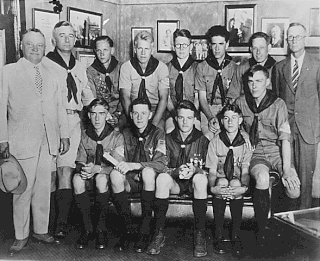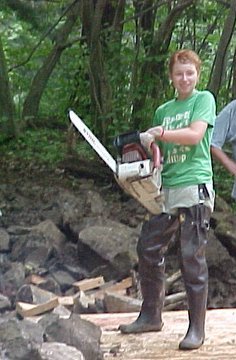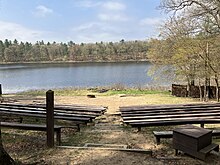
Scouting in Michigan has a long history, from the 1910s to the present day, serving thousands of youth in programs that suit the environment in which they live.

Scouting in Indiana has a long history, from the 1910s to the present day, serving thousands of youth in programs that suit the environment in which they live.

Scouting in Ohio has a long history, from the 1908 to the present day, serving thousands of youth in programs that suit the environment in which they live.

Scouting in Pennsylvania has a long and rich tradition, from 1908 to the present day, serving thousands of youth in programs that suit the environment in which they live.

The Greater St. Louis Area Council (GSLAC) of the Boy Scouts of America was formed in 1911 and is based in St. Louis, Missouri. The council serves Scouts in the St. Louis Metro area, southeast Missouri, and southern and central Illinois.

The headquarters of the Connecticut Rivers Council of the Boy Scouts of America is located in East Hartford, Connecticut. The present council was formed as the result of the merger between the Indian Trails Council of Norwich, Connecticut and Long Rivers Council of Hartford, Connecticut. Now it is the largest council in the state with a youth membership of over 17,000 and a volunteer base of nearly 10,000 adults, serving for over half of the state.

Scouting in Maine dates back to the creation of the Katahdin Area Council in 1920 and has continued prominently to the present day.

Minsi Trails Council is a council of the Boy Scouts of America that serves Scouts in the Lehigh Valley and the Pocono Mountains regions of eastern Pennsylvania and western New Jersey. In Pennsylvania, the council serves five counties: Lehigh, Northampton, Monroe, Carbon, and Luzerne. In New Jersey, it serves Warren County.

The Central Florida Council serves Boy Scouts in Orange, Osceola, Seminole, Lake, Brevard, Volusia and Flagler Counties in Florida. Its headquarters was previously located in Orlando, Florida and is currently located in Apopka, Florida, just north of Orlando. Its primary Scout camp is Camp La-No-Che in Paisley, Florida, adjacent to the Ocala National Forest.
The Great Lakes Field Service Council was a field service council of the Michigan Crossroads Council, a local council of the Boy Scouts of America. It served the Detroit metropolitan area and covers all of Wayne, Oakland and Macomb counties. The council had eight districts, one council service center, and four camp properties.

The Mid Iowa Council is a council of the Boy Scouts of America that serves all Scouts, adult volunteers and Venturers in Central Iowa. This includes the area of the state capital, Des Moines.

Northeastern Pennsylvania Council, with headquarters in Moosic, Pennsylvania, formed in 1990 from the merger of Forest Lakes Council and Penn Mountains Council of the Boy Scouts of America. It covers the metropolitan area of Scranton and Wilkes-Barre, Pennsylvania. The council serves Lackawanna, Luzerne, Pike, Wayne, Wyoming counties, and portions of Susquehanna county.

The Lincoln Heritage Council (LHC) is a local council of the Boy Scouts of America serving 64 counties in four states: Kentucky, Indiana, Illinois, and Tennessee.

The Northern New Jersey Council was formed in January 1999 and serves Bergen, Essex, Hudson and Passaic counties as an effort to better serve the Scouting communities encompassed in these areas.

Water and Woods Field Service Council was a field service council of the Michigan Crossroads Council that served youth in the central and northeastern Lower Peninsula of Michigan. The Council was headquartered in Flint, Michigan, with service centers located in Auburn, Lansing, and Port Huron. The Water and Woods Field Service Council was the result of a merger in 2012 of Lake Huron Area Council, Blue Water Council, Tall Pine Council and Chief Okemos Council.
The Bay-Lakes Council is the Boy Scouts of America (BSA) council serving eastern Wisconsin and the Upper Peninsula of Michigan. Headquartered in Appleton, Wisconsin, it is geographically one of the largest local BSA councils. Bay-Lakes Council #635 was formed on July 1, 1973, the product of a merger between six east Wisconsin councils. The council is served by Kon Wapos Lodge of the Order of the Arrow.
The Great Sauk Trail Council is a defunct local council of the Boy Scouts of America which was based out of Ann Arbor, Michigan serving Livingston County, Washtenaw County, Jackson County, Lenawee County, Hillsdale County, Monroe County, Eastern Calhoun County, and the city of Flat Rock, in Michigan.

The Michigan Crossroads Council (MCC) is a local council of the Boy Scouts of America that encompasses the Lower Peninsula of Michigan. The council was formed in 2012 by the merger of nine councils.
Pathway to Adventure Council is a Boy Scouts of America local council headquartered in Chicago, Illinois. Created from the merger of four councils, it now spans over a large portion of Chicago metropolitan area and part of Northwest Indiana. The council operates two camps and four service centers and has over 21,000 youth members.

Merritt Udell Lamb was the founder of scouting in West Michigan and the 13th Eagle Scout in the United States. Lamb was killed in action during the battle of Juvigny, France, on August 28, 1918. Lamb is currently buried in his hometown of Rockford, Michigan.



















